book at best price
Start
here.
here.
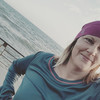
17.07.2019
A leak in the roof of the Festspielhaus, a sick leading actor in “Jedermann” and a “Buhlschaft” actress who doesn't care about the obligatory red robe and performs in a "little black dress". These were just a few of the unforeseen premieres at the Salzburg Festival in 2018.
For the first time in 2018 the leading actor of the “Jedermann” play fell ill and within 30 hours a replacement was found: they rehearsed and curtain up for another premiere! For this had never happened since the first “Jedermann” was staged in 1920: that a “Jedermann”, the male theatre role par excellence in Austria, fell ill at the time of performance. Of course, we thoroughly celebrate such artistic understudies - in this case, however, rightly so. The first “Jedermann” to step in in history! And then so brilliantly.

Jedermann in Summer 2018
When the summer festival is proclaimed in Salzburg every year, the city of Salzburg is both the backdrop and the stage. That’s what it's all about - since time immemorial. After the First World War the co-founder of the festival, Max Reinhardt, bought the nearby Leopoldskron Palace, which he also used to turn into a stage. Max Reinhardt's bust in the Festspielhaus has a rather strict look about it. The square in front of the Festspielhaus was named after him, the superstar of the German-speaking theatrical scene at the time: that is where you can sip champagne and beer on the red carpet - between “Jedermann” at Domplatz and Netrebko in the great hall. He was the one who wanted it exactly that way: "The whole city is a stage". And he succeeded, to this day.
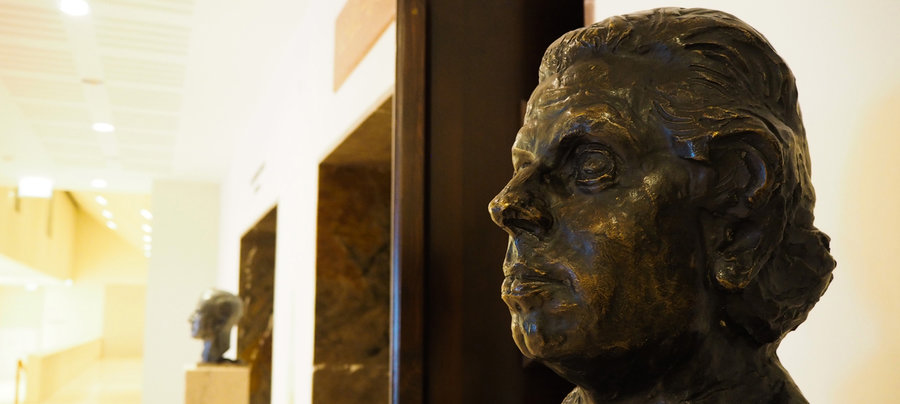
Max Reinhardts bust
His bust is not only seen by festival-goers, but also by all those who want to take a look behind the scenes of the performance venues: if you are lucky and don't disturb the rehearsals, you can get to all three venues on an official guided tour - in the auditorium and on the stage of the Grosser Festspielhaus, in the House for Mozart, backstage and also my personal highlight, the Felsenreitschule.
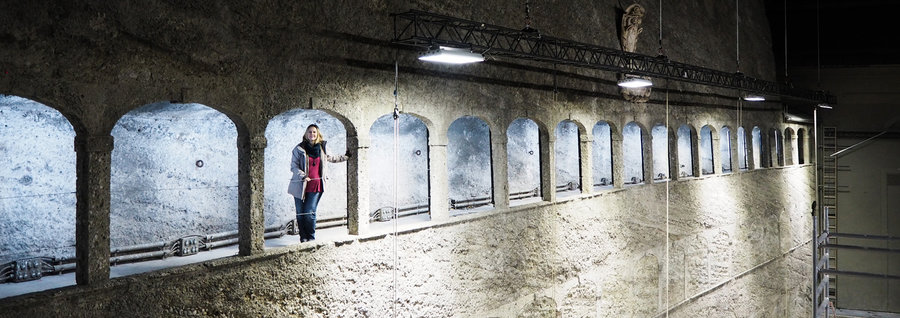
The arcades of Felsenreitschule
I have often been allowed to look behind the scenes of the Festspielhäuser during official and unofficial guided tours. I loved everything I saw – not surprising for a theatre lover. The porter talked shop with me about a past "My Fair Lady" production at the Vienna Volksoper, I was greeted friendly by every stage worker, everyone was highly concentrated at their work - from the carpenters to the suppliers. Professionals in their job and so friendly too, that’s nice.
If there is hammering, building and rehearsing going on all over the place, you often have to make compromises during the tour and are not allowed to peep in everywhere. In the rehearsal room in the Schüttkasten next to the Horse Pond, for example, speech rehearsals for “Jedermann” take place - or also concert rehearsals. Everywhere people are at work and as a visitor I am right in the middle of it as an observer and can look behind the scenes at everyone who makes the enjoyment of art possible in the first place: technicians, administrative staff, craftspeople, make-up artists and costume designers. During the guided tour you get a good impression of what happens in the background between the rehearsals and performances.
Today’s House for Mozart used to be the so-called Kleine Festspielhaus (small festival hall) and even earlier the Große Winterreitschule (large winter riding school), in between the provisional Festival Hall for Reinhardt's "Salzburg's Great World Theatre". The old riding school had to endure many alterations until it became as modern as it stands today as the House for Mozart. During the guided tour you enter the entire complex through the picturesquely colourful Faistauer foyer with the colourful frescoes by the Salzburg painter Anton Faistauer. From the backstage, a huge iron gate leads out onto the alleyway into the Toscaninihof. I have stood outside the gate so often - now I stand "on the other side" on the backstage. Exciting.

The Faistauer Foyer
Inside, by the way, in the ultra-modern main foyer, one can step out onto the terrace, which is especially worthwhile during the opening ceremony. If you are invited. Because from there, one has the very best view of the guests of honour who drive up and parade past for the opening. The stage curtain in the large Festspielhaus, which is where you move to if “Jedermann” at Domplatz is rained off, has a weight of 34 tons and is 1 metre thick. There, in the interval room, you can also see the remains of the "horse stable" when you walk on a green serpentine with horse mosaics.
After the winter riding school had been successfully rebuilt, Reinhardt also wanted the Felsenreitschule as a location for his world theatre: as early as the 17th century, 96 three-storey arcades were hewn into the quarry of the Mönchsberg in order to be able to watch riding performances (and unfortunately also animal fights). When they finally performed theatre here, they were still sitting on wooden benches and on clay floors.

Behind the arcades
Today the Felsenreitschule has an elaborate roof construction and a new grandstand with better views than before. But it is noticeable everywhere that here you are standing quasi in the middle of the Mönchsberg. The Karl Böhm Hall with the impressive ceiling fresco is also carved directly out of the mountain, as is the Felsenreitschule (“riding school in the rocks”). In the room that is now used as an interval foyer, one can also still see quite clearly what was really inside here 300 years ago: the very riding school that was later converted by the architect Clemens Holzmeister on behalf of Max Reinhardt. By the way, the tiny corridors and hiding holes behind the rock arches are not elitist at all. During the guided tour, visitors are very surprised when they see all the places the artists with their powerful voices have to slip through before they step onto the stage in their ostentatious costumes. The artists are by no means spoilt by luxury during their performance.
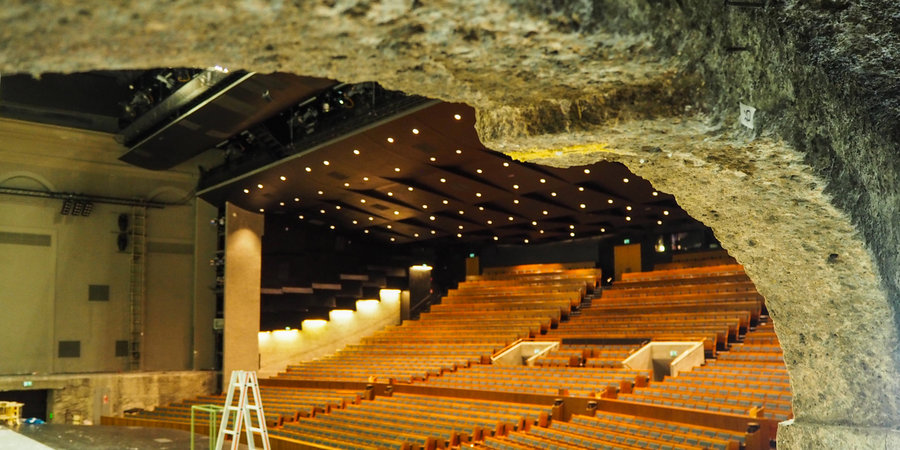
But that's exactly what makes this location so special. An opera stage carved into the rock, a foyer that was a riding school, frescos from the 17th century - and at the same time state-of-the-art stage technology, a sophisticated programme and artists from all over the world. But that’s why people like to mix amongst the enthusiastic masses of Salzburg visitors in Salzburg every year, isn’t it? I do, definitely. Again and again.
In the 1930s Salzburg was already regarded as the cultural centre of Europe alongside Bayreuth and in the summer months, similar to today, artists with followers, enthusiasts and many culturally interested "simple folk" spent weeks in the then still very small city. Due to his Jewish background, the work and life of Max Reinhardt were a very controversial topic in Salzburg until the Anschluss with Germany.
And even 50 (!) years ago it was already a matter for discussion in Salzburg: is the Festival still a highly cultural event, as the founders had intended, or spoiled by mass tourism? “Too many masses” lamented Helene Thimig, the widow of the founder Max Reinhardt, as early as 1970 about too much business and too little art in Salzburg. And the "smallest leading role in the world", that of the “Buhlschaft”, has always given rise to gossip. Favourite theme: the red dress worn by the “Buhlschaft”.
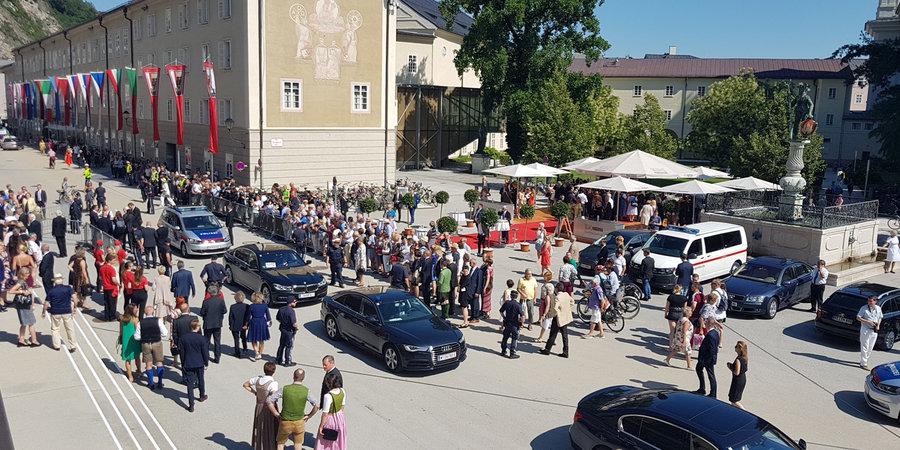
Yes, there is a lot going on in Salzburg: during the festival summer, the city is not only full of day tourists, holidaymakers, cultural enthusiasts and onlookers, but the cultural sector itself has also increased: instead of 200 employees, in summer there are over 5000 employees who live and work here and in the surrounding area. And they all want to park somewhere. Also the guests who are just here for the day or a few hours. By the way, the latter already existed in the 1960s - so they are not a product of today's mass tourism. Nevertheless, the fact that all the festival performances were booked to 97 percent on average over the summer was very pleasing. The official tours are in great demand and are offered once or several times a day. During the festival the times are sometimes different due to the many rehearsals and the extreme hustle and bustle, but it means that you are very close to the action.
Whether people will still be talking in 50 or 70 years time about the first person in history to step in as “Jedermann” back in 2018? Reinhardt's Faust production in 1933 was legendary right from the start: Clemens Holzmeister had built him a real "Faust town" in the Felsenreitschule, which at the time was still open to the sky. Of course, it began to rain during the premiere and everything had to be moved to the Festspielhaus. You know what it’s like. But that’s also part of Salzburg. Because:
Everywhere is a stage, everything is scenery. And everyone is playing a role. Me too.

Leopoldskron Palace
Anyone who doesn’t spend the day bathing at Lake Mattsee or Lake Wolfgangsee will perhaps use the day to climb the Kapuzinerberg, which is never overcrowded, and enjoy the view that Stefan Zweig once had from his refuge up there above the beloved, hated city before the Nazis burned his books here. Zweig used to avoid the festival season except for a few networking exceptions, while at the star Max Reinhardt’s (who he did not like) summer parties out at Leopoldskron Palace things really got going: Leopoldskron was Reinhardt's party zone, artist's forge, film location, travelling theatre and the founding site of the Salzburg Festival.
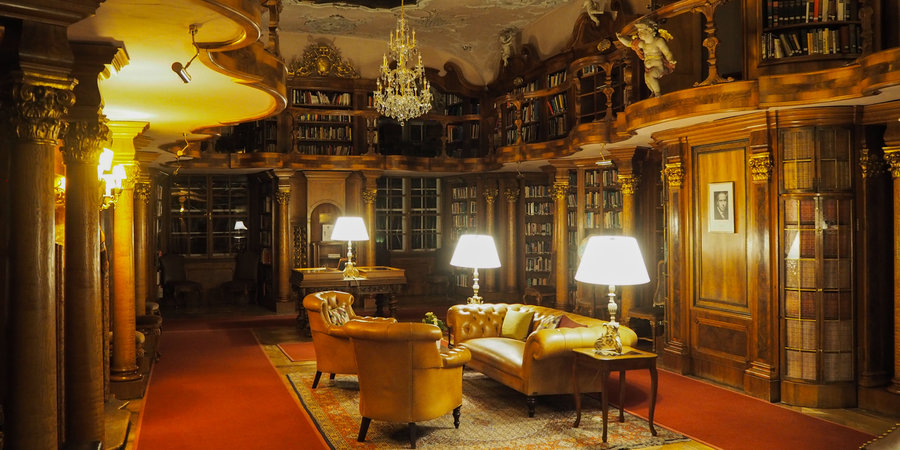
Max Reinhardt library at Leopoldskron Palace
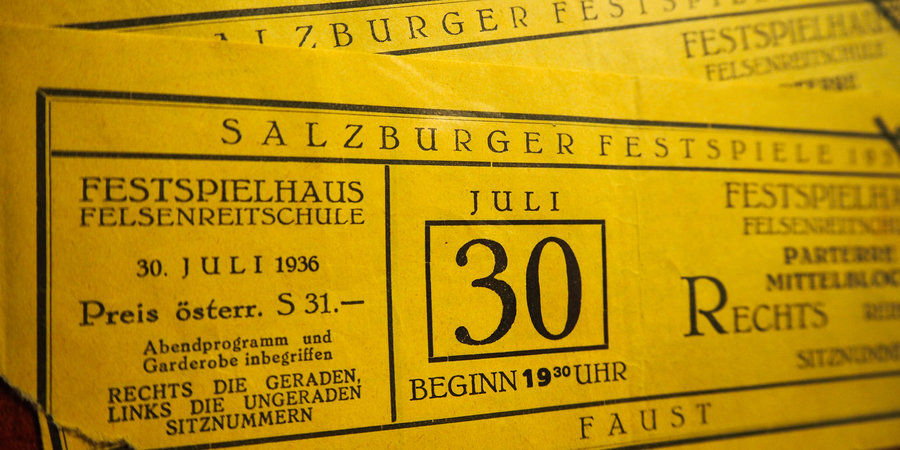
Historical items at Leopoldskron Palace
Today's Schlosshotel Leopoldskron is also a good photo location and only a short detour away from the performances: it is best to go by bike and take your bathing costume. Brave people jump into the Almkanal there, less adventurous ones go to the Leopoldskron outdoor pool. There, one also sees one or the other artist cooling down or cycling. Apropos cycling: you can sometimes meet the characters “Faith” on a bike or “Death” in the Café Bazar. The people from the good pieces quickly disappear after the performance and not everyone goes to the premiere party at the Stieglbräu restaurant. Eyes open in Salzburg during festival time: then you are really close to the cultural happenings.
In the evening, however, you slip into a traditional “dirndl” dress, leather trousers, pleated-front trousers, tuxedo or a small cocktail or full evening dress: because at the Salzburg Festival you can actually wear anything nowadays. You can definitely wear a “dirndl” dress at anytime and anywhere without attracting unpleasant attention - even as a non-local theatre lover and summer visitor.

I've been going to Salzburg in the summer for as long I can remember. For me, Salzburg simply belongs to the summer, no matter how many day tourists are flooding the city and how crowded the Getreidegasse may be. I love to have a ticket for a performance of “Jedermann” at 5 p.m. in my pocket, to cycle around the city and along the Salzach, to catch sight of an actor here and there and to hang out between the Domplatz and Festspielhaus after the performance. Nowadays you can be really part of it before and after the performance if you follow the artists on social media. Cold foot baths, cool drinks, a beer here, an artist’s party there, off into make-up. So I can be much nearer to the theatre - because that’s want I want.
After the performance I walk over to the Festspielhaus, because real insiders first book a performance of “Jedermann”, then have a drink on the red carpet before going to the opera in the Festspielhaus. Because for an onlooker like me, dressed in a dirndl and on a bike, there is a lot to watch.
By the way, I was also there when Jedermann fell ill in 2018. Well, more in a figurative sense, because I was cooling down my swollen festival feet in the fountain at Max Reinhardt Platz (surrounded by the opera audience in evening dress) after a "Bikram" performance of “Jedermann” at the overheated Domplatz, when the aforementioned “Jedermann” actor was taken to the dressing rooms in the Festspielhaus in a taxi. I'm sure it's freezing cold in the taxi, he’s bound to catch cold – was my first thought. And it seems that is just what happened. The whole city is a stage. If you like it or not.
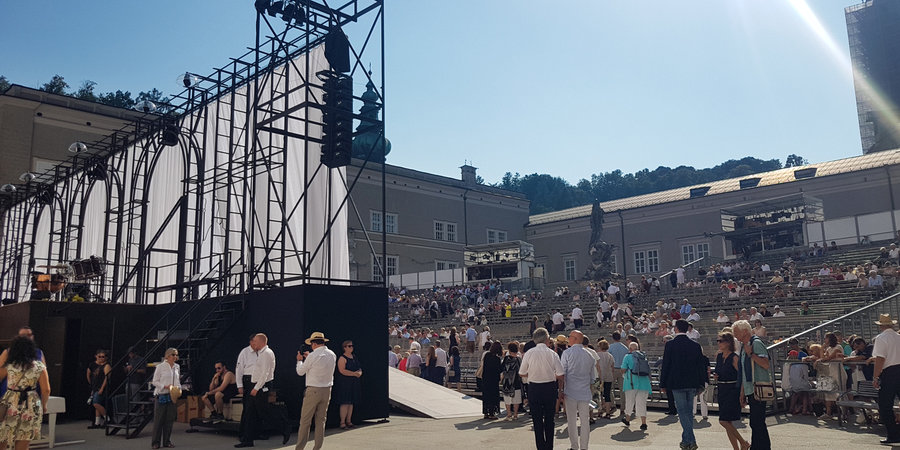
Salzburg Domplatz
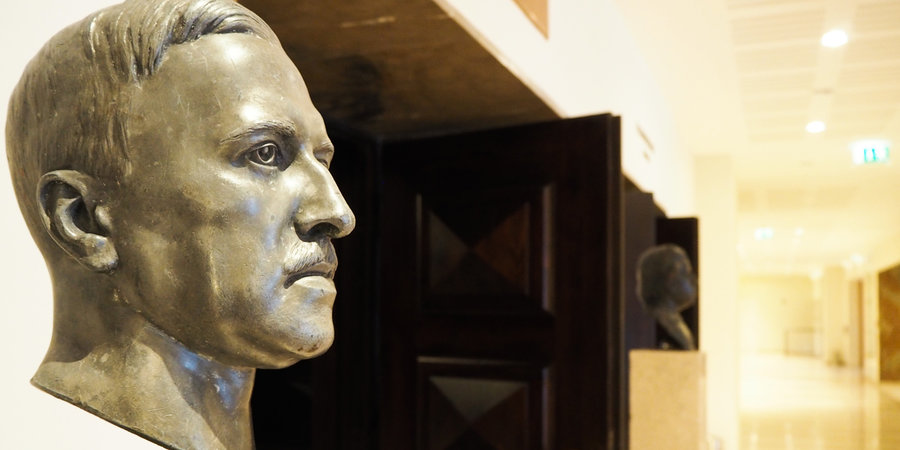
Hugo von Hofmannsthals bust
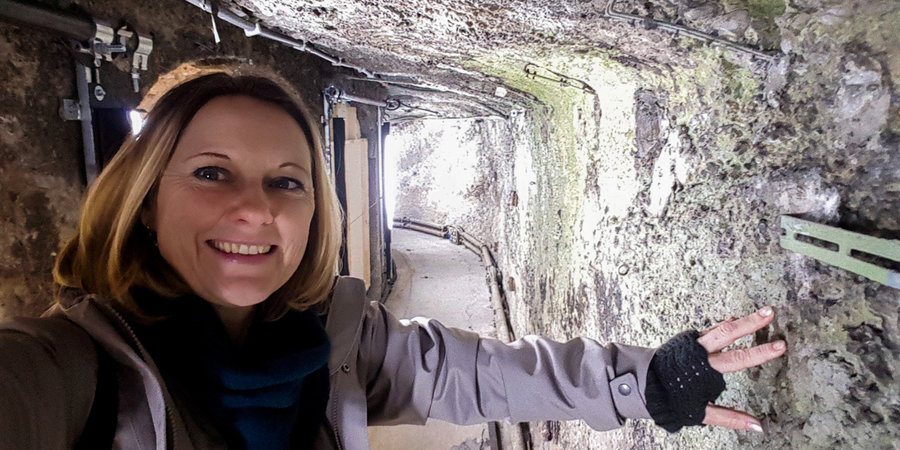
The riding school in the rocks
Of course you can find even more tips and inspiration for your Salzburg trip on our blog:
All pictures: © Angelika Mandler-Saul
| hotels: | Hotel Europa Salzburg, Hotel Salzburg Messe, Hotel Altstadt |